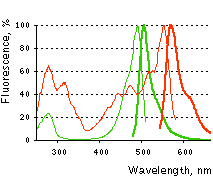
|
||||||||||
|
||||||||||

Dendra2
SUPPORT |
|
||||||||||||||||||||||||||||||||||||||||
|
Dendra2 is an improved version of a green-to-red photoswitchable fluorescent protein Dendra, derived from octocoral |
Main properties

Normalized excitation (thin line) and emission (thick line) for non-activated (green) and activated (red) spectra. |
| ||||||||||||||||||||||||||||||||||||
|---|---|---|---|---|---|---|---|---|---|---|---|---|---|---|---|---|---|---|---|---|---|---|---|---|---|---|---|---|---|---|---|---|---|---|---|---|---|
Recommended antibodies, filter sets, and activating parameters
Dendra2 can be recognized using Anti-Dendra2 antibody (Evrogen, Cat.# AB821-AB822, discontinued).
Primary Dendra2 visualization: Non-activated Dendra2 possesses excitation-emission maxima at 490 and 507 nm, similarly to EGFP and other green fluorescent proteins. Thus, commonly used fluorescence filter sets for EGFP, FITC, and other green dyes (e.g. Omega Optical QMAX-Green and XF100-2) are ideally suitable for Dendra2 green state.
A unique feature of Dendra2 is its photoconversion to red fluorescent state in response to intense-blue-light irradiation at 460-500 nm. In other words, light of the same wavelength is required for both visualization and photoconversion of Dendra2. Importantly, Dendra2 photoconversion occurs only at high light intensities, whereas Dendra2 green fluorescence can be detected at low light intensities. You should carefully select conditions allowing to detect green signal without undesirable photoconversion.
Photoactivation of Dendra2 and Dendra2-tagged proteins: Dendra2 can be photoconverted by light irradiation in either UV-violet (360-420 nm) or blue region (460-500 nm). We recommend that you use 405 nm diode laser or 488 nm Ar laser line. 405-nm laser provides more efficient photoconversion compared with 488-nm laser. However, intense UV-violet light can be harmful for cells.
Tracking Dendra2 and Dendra2-tagged proteins after activation: Activated Dendra2 protein possesses excitation/emission maxima at 553/ 573 nm. Thus, TRITC filter set or similar (e.g. Omega Optical QMAX-Yellow and XF108-2) can be used for activated Dendra2 visualization. Under the confocal microscope, the red fluorescent signal can be acquired using 543-nm excitation laser line and detected at 560 — 650 nm.
Application note: Dendra2 photoconversion with the Zeiss LSM 710 laser scanning microscope.
References:
- Gurskaya NG, Verkhusha VV, Shcheglov AS, Staroverov DB, Chepurnykh TV, Fradkov AF, Lukyanov S, Lukyanov KA. Engineering of a monomeric green-to-red photoactivatable fluorescent protein induced by blue light. Nat Biotechnol. 2006; 24 (4):461-5. / pmid: 16550175
|
Copyright 2002-2023 Evrogen. All rights reserved. Evrogen JSC, 16/10 Miklukho-Maklaya str., Moscow, Russia, Tel +7(495)988-4084, Fax +7(495)988-4085, e-mail:evrogen@evrogen.com |


